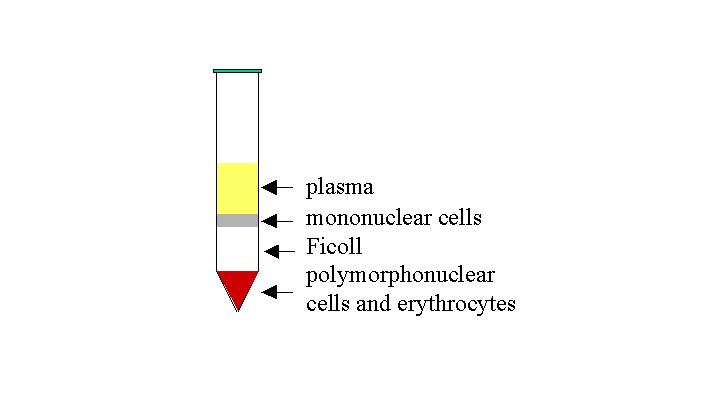
Lab 3. Separation of Peripheral Blood Components
In this lab exercise, you will learn how to use density gradient centrifugation to separate peripheral blood components. Peripheral blood is the common source of lymphocytes for studies of the human immune system. Density gradient centrifugation is a simple and rapid method for the purification of different components of peripheral blood. It takes advantage of the density differences between different components of peripheral blood. When the blood is centrifuged through a Ficoll-Hypaque density gradient, mononuclear cells, which have a relatively low density, collect in the first band near the top of the Ficoll gradient. Mononuclear cells include lymphocytes and monocytes. Granulocytes and erythrocytes, which are denser, pellet at the bottom of the tube. Plasma, which contains lighter and soluble components of the blood, including antibodies, is on the top of the tube. Monocytes can be separated from lymphocytes by placing the cells in a tissue culture flask at 37oC for 24 h. Monocytes will adhere to the flask while lymphocytes will remain in suspension.
Safety Note: Human blood is used for this experiment, so wear GLOVES. Also dispose of all materials contacting blood in BIOHAZARD WASTE.
Procedure
1. Each group should get 5 ml of blood that has been collected in a tube containing 1 unit of heparin. Transfer the blood to a 15 ml polypropylene centrifuge tube.
2. Add an equal volume of PBS and mix well.
3. Slowly and carefully underlay the mixture with 3 ml of Ficoll. Do not mix the two layers.
4. Centrifuge for 30 minutes at 900 X g at room temperature with no brake. Make sure that the centrifuge is balanced before it is started.
5. After centrifugation you will see that various layers have formed. To see what is in each layer, take a drop from each layer and place it on a microscope slide. Make a smear and let it dry.
6. Dip the slides in Wright stain for 15-30 sec. Dip in deionized water for 30 sec. Rinse with distilled water and air dry. View the slides under a microscope and determine the cell types present.
Reading
Immunobiology A-20Study Questions
1. What is the name of the method that you have used to separate different peripheral blood components?
2. After centrifugation, what are the major components in each layer of the Ficoll density gradient?
3. Can you separate neutrophils from erythrocytes or B lymphocytes from T lymphocytes using the Ficoll density gradient centrifugation, and why?
4. How can you separate monocytes from lymphocytes?
